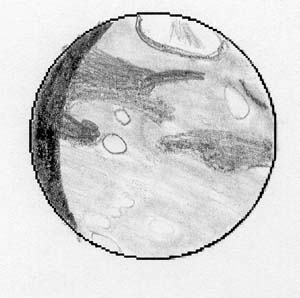
Sketched July 17, 2003 from my back deck 3:30 a.m. pacific DST (daylight savings time) or 10:30 UT.
| Date: 07/17/03 Lat 37.6N, Long 122W, elev. 200 feet | Sketch Time (UT): 10:30, (local time): 3:30 a.m. DST |
| Central Meridian: 174° | Filters: none |
| Instrument: 4-inch (105mm) f/6 Astro-Physics Traveler Apo refractor. | Distance from earth 0.48 AU, 72m km, 45m miles |
| Magnification: 376x (4mm Zeiss Abbe Ortho combined with a 2.4x AP Barcon Barlow) | Transp. 3/6, Seeing 9/10, Antoniadi (I-V): I - II |
| Apparent Size: 19.6" | Magnitude: -1.9 |
South Polar cap (top) shows a bald spot where the carbon dixoide ice is melting and is ringed with a dark melt line, the area of Martian earth uncovered as the polar cap receeds. Below and to the right of the south polar cap (north and to the far right) is a white spot. The white spot is Eridania. North (below) is the albedo feature Mare Siremum (the lump) tapering to Mare Cimmerium. A ""C" shaped feature has fully rotating on since the previous sketch. Different Mars maps show this as Mare Chromium or Phaethontis. On the terminator is Bosporus Gemmatus (or Mare Erythraeum). Below this is Solis Lacus (dark) and Syria is the light area. The Tharsis volcanoes and Olympus Mons again can be seen as subtle lighter areas near north limb. Arcadia, not the North Polar cap, can be glimpsed right below the cloud tops of the third (lowest) Tharsis caldera.
Mars, in this sketch is reversed N/S. South is shown at the top of the image. The south polar cap is the prominent feature. Terminator is where daylight ends and evening begins. The terminator is on the left and the planet is rotating left to right. In my sketches the planet rotates martian east (left) to west (right) to match most other images and sketches. Look for features rotating from left to right in the drawings.
Details about Mars: Diameter 19.6 arc seconds (Jupiter is about 30 -50 arc seconds in diameter depending on its distance from earth). Central Meridian 141 - the imaginary line passing through the planetary poles of rotation and bisecting the planetary disk, and is used to determine the longitude during an observing session.

White Oaks Home | Sketches Index | Mars 2003 Index | Back | Next